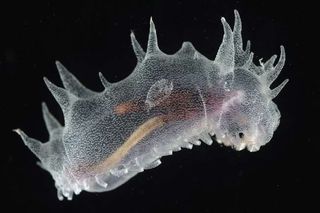
Deep Seafloor Surprisingly Alive, Discoveries Reveal

Scientists from the United Kingdom and 16 other nations have just returned from an expedition to explore a never-before-seen area of the ocean floor. Instead of the barren, sparsely inhabited environment some expected to see, scientists brought back pictures of a mysterious world that is teeming with life.
The research focused on the Mid-Atlantic Ridge, a massive, undersea mountain range which essentially splits the ocean in half, dividing east from west. The seascape, featuring rocky outcroppings, sheer cliffs, and flat, open plains, might look familiar to anyone who has spent time in the American west. The residents of this ridge, however, are decidedly exotic.
At least 10 creatures that possibly represent new species were discovered during the six-week journey aboard the U.K. research vessel the James Cook.
Exploring the seabed
Scientists sent a remotely operated vehicle, the Isis, on dives lasting up to 30 hours, down to depths of up to 12,000 feet (3,600 meters). Outfitted with 10 high-definition, studio-quality cameras and powerful lamps to illuminate the darkness of the sea floor, the van-sized ROV took hours of footage of myriad species, all interacting in their natural habitat.
Of particular interest are three new species of brightly colored enteropneust, a kind of deep-sea worm. The small invertebrates, about four inches (10 centimeters) long, had previously been found only in the Pacific Ocean.
{{adsense|premier|left}}
Sign up for the Live Science daily newsletter now
Get the world’s most fascinating discoveries delivered straight to your inbox.
Professor Monty Priede, director of the University of Aberdeen's Oceanlab, said it was a pink enteropneust they saw first.
"It was a very exciting moment. We said, 'Ah, we’re the first people to see this!'" Priede said. "Other samples have been fragmented and broken up – we were the first to get specimens of these animals."
For Priede, the real eureka moment came when the team saw one of the worms actually swimming.
"It was just floating in the water, curled up and drifting along in the current," said Priede. "But when it perceived our presence, it held its tail straight, almost like a human diver, and went shooting down to the bottom."
Priede said that the eyeless creatures can't actually see, but the worm must have somehow sensed the Isis lurking nearby.
An evolutionary discovery
The discovery of the new worm species was important, Priede said, because these creatures represent "the base of the chain of evolution. They're not the missing link, but they’re very close to it."
Dr. Daniel Jones, of the UK's National Oceanography Centre, said it was the rocky regions of the Mid-Atlantic Ridge that were most surprising. "We really didn't know what to expect," he said.
Researchers found new varieties of cliff-dwelling, uncharacteristically active sea cucumbers, corals several meters tall that might be a thousand years old, and sea lilies, which are marine animals that look like flowers.
Priede said the Cook's expedition, part of the international Census of Marine life, opens a new chapter in our understanding of ocean populations.
"There's plenty of real estate out in the middle of the ocean where these animals are living," he said. "We're realizing there's much more habitat out there than we realized. So that will turn around our whole idea about how life is organized in the ocean as a whole."
- Hidden Deep-Sea Corals Revealed
- Mystery Explosion of Wormlike Creatures on Seafloor Explained
- World’s Oceans Remain Largely Mysterious
This article was provided by OurAmazingPlanet, a sister site to LiveScience.
